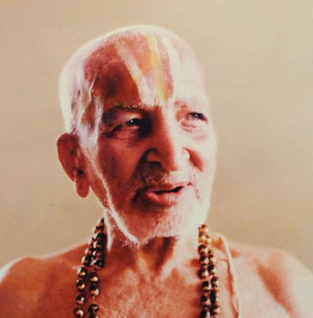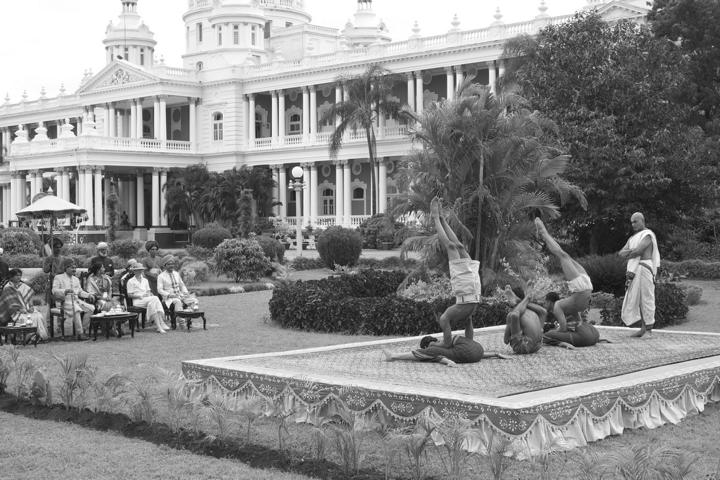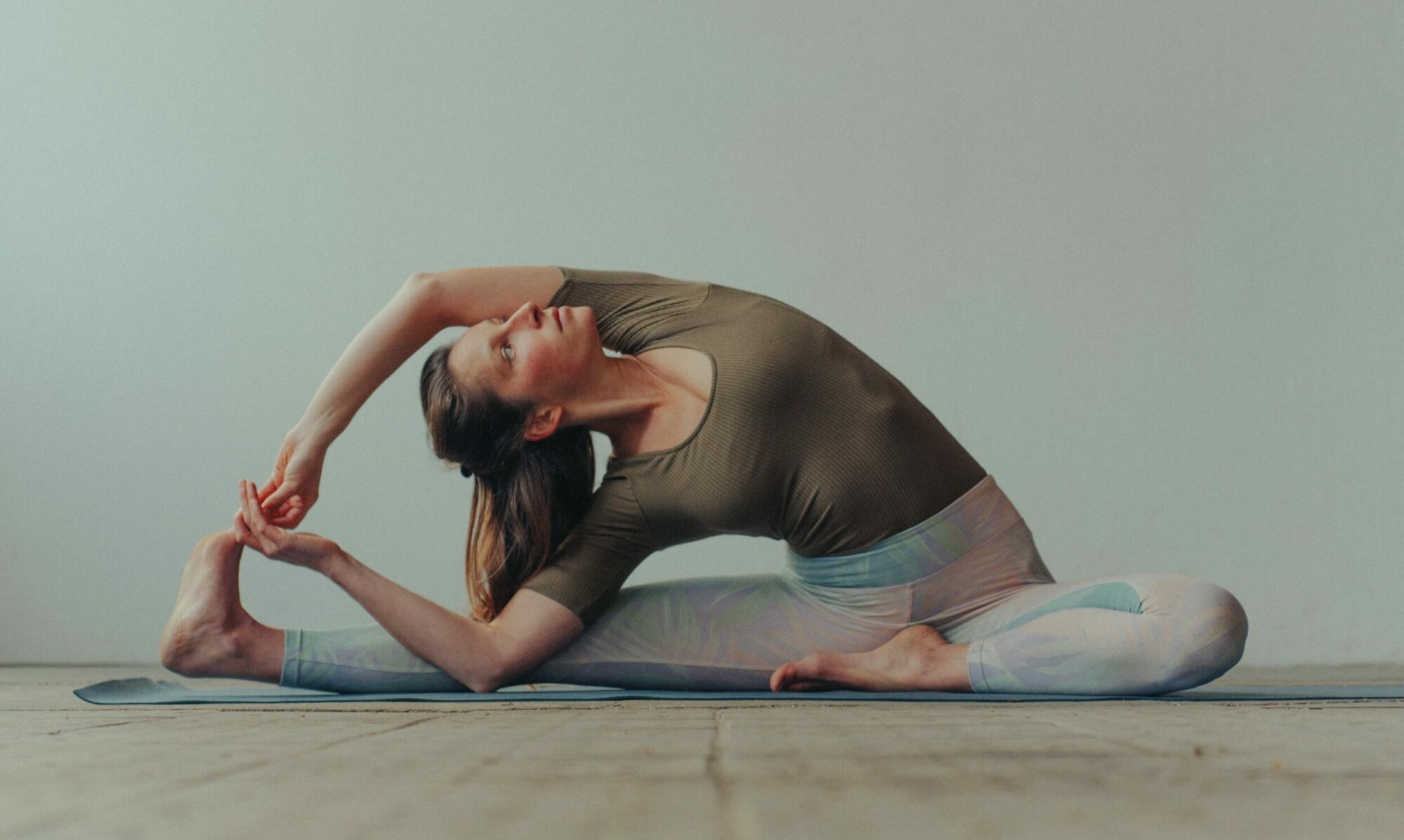
Tirumalai Krishnamacharya (1888 – 1989)
Esteemed and famous scholar of Indian scriptures, pioneer of Hatha Yoga in modern times and Ayurvedic healer of India.
He was born into a Brahmin family and was initiated into the holy scriptures by his father from the age of 5.
From 1916 – 1924 he went to the Himalayas, where he visited Sri Ramamohan Bramachari in a cave in the Himalayas on Kailash to study with him for 7 ½ years. There he learned 3000 asanas and pranayama, and in particular other ancient scriptures. As was traditionally the case, they were passed on orally. As a parting gift, the master gave him the task of looking for a book entitled “Yoga-Kurunta”, which he finally found as a copy in a library in Calcutta. This is considered to be the only book in which the traditional physical exercises were written down. Unfortunately, it was then eaten beyond recognition by ants. So the tradition goes.
Here is a movie from 1938 (!) in which Krishnamacharya himself can be seen.
In 1924, he returned to Mysore, married and started a family. The Maharaja of Mysore asked him to come and teach the royal family members yoga asanas. This was followed by the opening of the yoga shala, where Krishnamacharya taught yoga in the name of the maharaja, first to the royal family and then to the general public.
The physical exercises of yoga become a “popular sport”
Yoga exercises were not yet a popular practice, as one might think from today’s Western perspective. There were fakirs who showed off their considerable skills at markets, but they were ascetic eccentrics. Yoga was frowned upon until then. Krishnamacharya therefore had to do pioneering work. He was a very experimental and forward-thinking man; it was Krishnamacharya’s life’s work that the physical exercises of yoga became a “popular sport”.
The Maharajah of Mysore wanted to create a strong royal family and a strong people in the British-occupied India.

Interestingly, Krishnamacharya was not the only one at the Mahardasha’s court who promoted physical training.
Reto Zbinden’s review of Marc Singelton’s book “Yoga Body – The origins of modern Posture Practice” – the history of modern body yoga – is highly interesting and gives a deep insight into the trends of the time.
The motif of pure physical training coincided almost simultaneously with efforts in Germany and Europe, when physical exercises were introduced to “train the people”. Ling’s Gymnastics”, a training system of the Swedish army of the 19th century, and later the Danish Gymnastics according to Niels Bukh, both of which were used by the British military in India , and numerous other forms of physical training such as weight training (bodybuilding) were popular at the court of the Maharaja at this time.
He developed a very dynamic and challenging, acrobatic style of practice from all these currents, which was constantly varied and suited the young people very well. This was entirely in keeping with the task that the Maharaja had set him. These impulses were continued in different ways in Pattabhi Joi’s Ashtanga Yoga and Iyengar Yoga. It was pure physical training.
Considering that there was a lively exchange between the continents due to England’s colonial rule, it is not entirely surprising that the two endeavors merged early on.
Changes in the second half of life
When the British occupying power withdrew from the country and India became independent, the yoga shala in Mysore was also closed and Krishnamacharya moved to Madras to live in poor conditions. There he taught almost exclusively in individual classes or very small groups. It is not clear from the literature whether this was due to the lack of space or a principle of teaching. He did not have fixed sequences of exercises, but practiced them in an experimental manner, always with new selections and individually tailored to the student. This individual relationship is remarkable because he released healing powers for his aspirants. He used yoga for healing purposes and, according to tradition, liked to read mantras from the holy scriptures and recite them during the practice.
Krishnamacharya taught until his death – he was 101 years old – and reportedly had amazing powers. For example, it is reported that he was able to stop his heart for two minutes and healed a severe pelvic fracture himself at an advanced age. He was able to unleash amazing healing powers in himself and his patients. On the other hand, the physical exercises, at least when he was spreading yoga among the population on behalf of the maharaja, were very material and purely physical.
His most famous students are:
Indra Devi (1899 – 2002) one of the few women, she went to America and spread yoga there, as well as B.K.S. Iyengar and Patthabi Joiswho will be discussed in more detail later.
The eldest son TKV Desikachar (1938- 2016) learned from his father in the last 30 years of his life. In Madras / Chennai, he ran an international yoga school until his death. This approach and style became known as Viniyoga , which he has continued to teach in his tradition to this day. Desikachar is just as modest and inconspicuous, although he became world-famous through his father. Like his father before him, he also taught free of charge at his center in Cennai (Madras). He financed his upkeep through donations.
Krishnamacharya was a pioneer of hatha yoga, but he was not the only one, as is often portrayed in the West. There are various sources and numerous pioneers, some of whom are described here on the Yoga Styles in Comparison page, such as Swami Sivananda, who also contributed to the spread of physical exercises.
Further reading and film recommendations:
The feature film “The Breathing God” by Jan Schmidt-Garre (2012) provides an insight into Krishnamacharya’s life and work using historical film and image material (partly re-enactments), as well as interviews with contemporary witnesses, in particular his living family members, his students BKS Iyengar and Pattabhi Jois.
Further background information and a critical review of the film by Reto Zbinden (Yoga University Villeret, Switzerland): Krishnamacharya in the light of his followers (2)
Book: “Yoga and the realm of the deceased – some important personalities of yoga and their continued influence after death” by Heinz Grill.
A vita of Krishnamacharya can be found in Aurora Wiki can be found. It quotes in detail from the above-mentioned book on the soul of Krishnamacharya with regard to his person and work.
Go to page: T.K.V. Desikachar – Vini Yoga
Bildquellen
- : Wikipedia | Public Domain Mark 1.0
- K640_3 Pars Media- Mysore: Mit freundlicher Genehmigung von Parsmedia | All Rights Reserved
